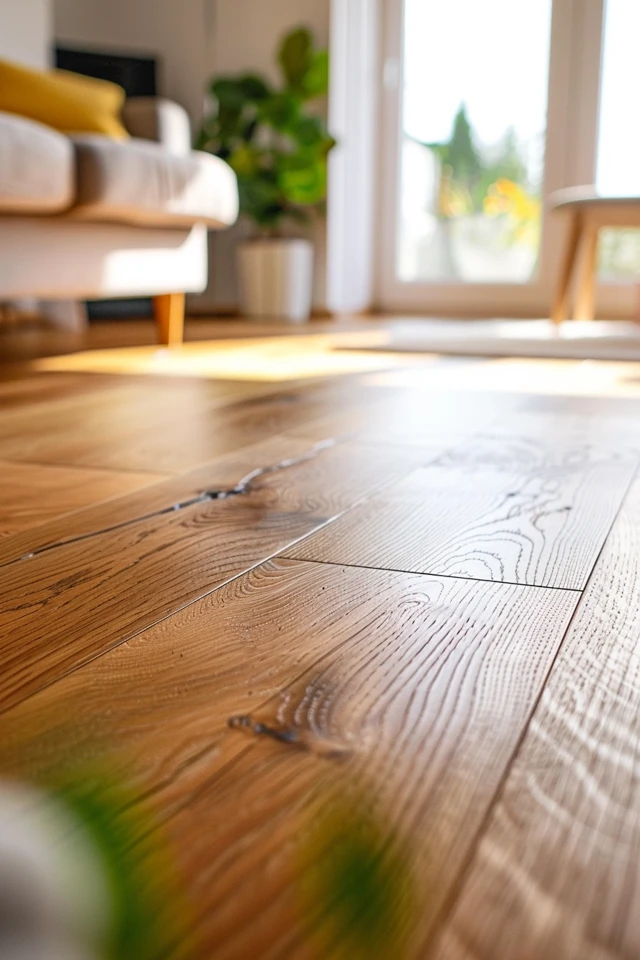Are you tired of dirt and debris collecting in the gaps between your hardwood floorboards? Maintaining clean and crack-free hardwood floors not only enhances the overall appearance of your home but also prolongs the lifespan of your flooring. Regular cleaning is essential to prevent the accumulation of dirt and grime in these hard-to-reach areas.
In this deep cleaning guide, I will provide you with effective techniques and tips to keep your hardwood floors looking pristine, while ensuring the longevity of your investment. From removing loose dirt to scrubbing out ground-in residue, I will take you through step-by-step instructions on how to clean between hardwood floor cracks.
Key Takeaways:
- In order to maintain clean and crack-free hardwood floors, it is important to clean the gaps between floorboards regularly.
- Use a vacuum to remove loose dirt and a plastic putty knife to scrub away ground-in residue.
- Fill in larger gaps with a wood filler that matches the color of your floors.
- Run a damp mop over the cracks and use a white vinegar solution to remove grime.
- Cleaning hardwood floors weekly is crucial in preventing dirt buildup and maintaining their beauty.

How to Fill Gaps in Hardwood Floors
To maintain the beauty and structural integrity of hardwood floors, it’s important to address and fill gaps that may develop over time. Whether you have gaps between wood floorboards or cracks in the floor, there are several solutions you can try to effectively fill in the gaps and restore the seamless appearance of your hardwood floors.
1. Run a humidifier when there’s dry weather: Dry weather can cause hardwood floors to shrink, leading to gaps between the floorboards. Running a humidifier can help restore moisture levels and reduce the gaps, ensuring a more snug fit.
2. Apply a wood filler: For larger gaps, you can use a wood filler specifically designed for floor cracks. Choose a filler that matches the color of your floors to achieve a seamless blend. Apply the filler into the gaps, ensuring it completely fills the space.
3. Try a mixture of sawdust and epoxy: For smaller cracks, you can create a mixture of sawdust and epoxy. Mix the two ingredients until they form a paste-like consistency. Apply the mixture into the cracks and wipe off any excess for a smooth finish.
4. Fill grooves between wide-plank floors: Wide-plank floors often have grooves between the boards. To fill these gaps, you can use natural-fiber rope. Measure the length of the groove and cut the rope to fit. Press the rope into the groove, ensuring it sits flush with the surface of the floor.
5. Tap laminate boards together: If you have laminate flooring with visible gaps, you can use a mallet and suction cup tool to tap the ends of the boards together. This technique helps close the gaps and creates a more seamless appearance.
6. Consider sealing air vents and insulating walls: In some cases, gaps in hardwood floors may be caused by underlying issues such as uneven subflooring or improper insulation. By sealing air vents into the crawl space and insulating walls, you can stabilize the floorboards and minimize the occurrence of gaps.
Remember, when filling gaps in hardwood floors, it’s essential to use a flexible and color-matched filler that can withstand the natural expansion and contraction of the wood. Look for products like Color Rite acrylic caulking, which provides a durable and seamless finish.
By following these techniques, you can effectively fill gaps in hardwood floors and restore the beauty and integrity of your flooring. Regular maintenance and prompt attention to gaps will help keep your hardwood floors looking their best for years to come.

Conclusion
In conclusion, maintaining the cleanliness and condition of hardwood floor gaps is crucial for preserving the overall integrity of your flooring. By regularly cleaning these gaps with the appropriate tools and products, you can effectively remove dirt, dust, and debris that tend to accumulate over time. This will not only improve the appearance of your hardwood floor but also contribute to its longevity.
Additionally, filling gaps in your hardwood floors is an essential step in preventing further dirt accumulation. By using suitable wood fillers that match the color of your floors, you can close these gaps and create a seamless surface. This not only enhances the visual appeal of your flooring but also minimizes the chances of more dirt and debris getting trapped in the future.
Furthermore, proper maintenance practices such as using a humidifier and insulating the crawl space can help stabilize the floorboards and minimize the occurrence of gaps. By restoring moisture levels and providing structural support, you can reduce the risk of gaps forming and ensure the long-term stability of your hardwood floors.
By following these guidelines for hardwood floor gap maintenance, you can achieve cleaner, more pristine floors that will continue to shine for years to come. Remember to clean regularly, fill gaps when necessary, and implement proper maintenance strategies to keep your hardwood floors looking their best.


